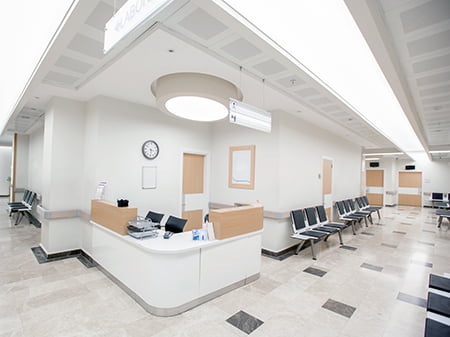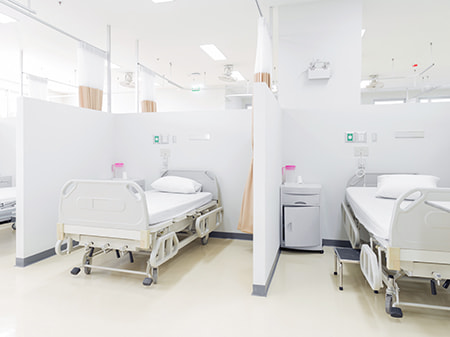Top Benefits of Sound Masking for Offices and Workspaces
Sound masking technology offers proven benefits across various environments—from enhancing speech privacy in healthcare settings and supporting patient rest, to minimizing distractions in open-plan offices and creating a quieter, more focused workspace. These advantages are backed by numerous scientific studies.
Making Open Offices Less Distracting and More Private
It's yesterday's news: open-plan offices may be paved with good intentions but they're also filled with unsatisfied workers. They're not exactly getting the best of press lately either. What makes them so increasingly unpopular? Too little privacy and too many distractions. Two major complaints that are inextricably linked to space acoustics—a key aspect of occupant comfort which is still too often downplayed in office construction projects.
Of course, sound travels very easily throughout open-plan offices, given that there are no doors or walls to stop it. Because of this, private conversations between colleagues or over the phone can be clearly heard by pretty much everyone across the floor. This not only makes it difficult for workers both nearby and further away to get into flow and concentrate on their tasks, but it also makes everyone uncomfortable about being themselves, discussing private matters or simply collaborating, in fear of disturbing others or being overheard by the wrong persons.
Reducing Distractions in Open-Plan Offices with Sound Masking
Sound masking improves employee focus and performance in open-plan offices by reducing the radius of distraction—the distance at which surrounding noise becomes disruptive.
A study by Valtteri Hongisto at the Finnish Institute of Occupational Health showed that workers were significantly less distracted by conversations and background noise within 15 to 40 feet of a sound masking speaker. This proves how effective sound masking can be in busy, collaborative environments.
Acoustic Privacy Without Walls
Open offices may lack physical barriers, but they don't have to lack acoustic privacy. While employees can see each other, they shouldn't hear every word being said nearby.
Sound masking makes surrounding conversations less intelligible, helping employees concentrate without needing walls or private offices. It turns open-plan spaces into more focused, comfortable workplaces, supporting both collaboration and productivity.

Sound Masking Can Solve Two of the Biggest Complaints About Open-Plan Offices
By adding a continuous, low-level ambient sound to an environment, sound masking can help make conversations for listeners that aren’t intended to hear them unintelligible, and therefore much easier to ignore.
Fewer Distractions and More Privacy Mean Higher Workplace Productivity
Sound masking is a remarkably profitable investment. Studies show an average increase in office worker productivity between 10% and 25% after integrating office sound masking technology. But even a 5% increase is enough for the typical office sound masking system to be completely paid off in just a little over a month.
Calculate your ROIWhat Researchers Say About Open Offices and Sound Masking
Appropriate sound masking is necessary to achieve acceptable speech privacy between two neighbouring workstations [...] A significant improvement in objective speech privacy occurred after installing a sound masking system [...] The need for further acoustic improvements became negligible because major acoustic problems no longer existed after installing a sound masking system.
The main argument in favour of open plan offices is the expected reduced cost relative to closed offices with full height partitions. The cost savings may be a little reduced with the extra expense of meeting acceptable speech privacy requirements. However, these additional costs are usually assumed to be small relative to the costs of decreased performance by distracted office workers [...] A successful open office should include an optimum masking sound spectrum.
An ideal ambient noise level is approximately 45 dBA. If the noise level is much less, speech privacy will be substantially reduced. If it is much higher, the noise will be a source of annoyance and may reduce speech privacy because people will talk louder. The maximum noise level should therefore not exceed 48 dBA. Because it is important to achieve an ambient noise level within a very small range of levels, and because noise levels should be evenly distributed throughout the office, this is usually best achieved using electronic masking noise. Of course, this also allows the spectrum, as well as the level, of the masking sound to be optimally set to maximize the speech privacy without undue disturbance.
Sound masking systems can be used to add neutral background noise that will cover speech sounds and other distracting noises. Sound masking is an effective way to lower the speech intelligibility index (SII) and create good acoustical conditions. Laboratory simulations have also found that sound masking improves the execution of complex cognitive tasks and reduces perceived stress.
Hybrid Workplaces & Adaptive Sound Masking Technology
In today's increasingly popular hybrid workplaces, everyone doesn’t necessarily have their own desk assigned, or at least not permanently so. On any given day, employees can choose a place in the office where it's most suitable for them to complete specific tasks, ranging from focused individual work to team collaboration to formal meetings or impromptu one-on-ones. In fact, employees may even choose not to be in the office at all, opting to work from home because it just makes more sense on certain days. You believe in workplace flexibility or you don't, period!
Reconciling the Need to Collaborate and the Need for Privacy
Activity-based and hybrid working environments also mean that no two days are ever exactly alike, especially in terms of work atmosphere. The office's soundscape can vary a great deal throughout the week, from buzzing and lively to pin-drop silent, almost church-like, based on the ever-changing nature of employee activity and office occupancy. In the end, there'll always be employees who need to collaborate in proximity with employees who need to focus alone, distraction-free. Sound masking technology can help you reconcile these two very different needs within a same space.

Drowning Out Noisy Distractions While Smoothing Out the Office Soundscape
On busier days, sound masking seamlessly blends in the relatively high office background noise level, while continuously adjusting itself to noisier spikes, which mostly arise from verbal communications, and quieter lows. Simply put, the sound masking volume automatically increases as the office gets noisier, and decreases as it becomes quieter. That way, employees consistently experience the same optimal level of acoustic privacy and comfort no matter how busy or quiet their work area gets.

Ensuring Good Acoustic Privacy and Comfort When the Office Is Very Quiet
When workspace activity and occupancy levels are at their lowest, the office's sound masking system subtly increases the ambient sound level just enough to drown out distracting noises stealing employee’s focus, but without this little extra background sound becoming a source of distraction in itself. What’s more, sound masking also helps ensure that any private conversation carried amid the otherwise quiet workspace remains confidential and unintelligible to other employees.
Making Private Offices & Meeting Rooms Really Private
Lack of privacy is a problem, but the illusion of privacy is a greater problem. This is especially true for enclosed offices, boardrooms, medical exam rooms, interrogation rooms, and any space intended for confidential, sensitive information sharing. Conversations carried behind a closed door should never be heard by the people outside, or next door for that matter. But it happens—a lot more often than we'd like to think. We've stopped counting the number of times facility professionals and workspace designers alike reached out to us emphasizing the following issue word for word:
Conversations can be heard from outside meeting rooms when the rest of the office is very quiet.
As acoustical engineers, we frequently come across private rooms which aren't so private afterall. In most cases, lack of acoustic privacy is a combination of poor noise isolation, unsuspected sound leak paths, loud conversations, and excessively low background sound levels, all of which are commonly found in many settings where confidentiality actually matters: corporate offices, government agencies, law enforcement, and, of course, healthcare facilities.
Is Your Office Space Too Quiet for Private Conversations?
Just imagine a private, sensitive conversation carried in a closed room, door fully shut, but in the middle of a dead quiet open floor plan where the sound of a dropped pencil immediately grabs everyone’s attention. How private is this conversation really? Architects and interior designers tend to focus almost exclusively on a room's architectural sound transmission loss, paying extra attention to the STC rating of walls and doors, but all too often overlooking the background sound factor. Meanwhile, achieving better accoustic privacy between rooms through higher background sound levels is definitely simpler and cheaper than improving the sound isolation performance of existing partitions.
Higher Background Sound Levels Mean Better Acoustic Privacy Between Rooms
So you think your private offices and meeting rooms are completely isolated from each other and the rest of the workspace? Think again. Sound leakage will always happen to some extent. And whatever amount of sound makes it way through the walls, door, floor, and ceiling—out of the room and into the next one—will be heard by anyone working quietly there. How clearly private conversations leaking through are going to be heard outside or nextdoor depends on one thing: the background sound level at the listener's position. Sound masking gives you total granular control over your office's background sound level, increasing it just enough to reduce speech perception between enclosed and open work environments.
Sound Masking Technology Reduces Office Construction Costs While Improving Design Flexibility
By elevating ambient background sound levels uniformly across spaces typically so quiet that even distant conversations—including private ones carried behind closed doors—are clearly overheard, a well-designed sound masking system improves the signal-to-noise ratio which in turn reduces speech perception just like any physical partition would. Sound masking thus provides a cheaper and more flexible alternative to deck-to-deck construction. It also reduces the need for plenum barriers, specialty acoustic insulation, and extra drywall layers. Office construction and soundproofing costs can be reduced by up to $3 per square foot.
Learn the Fundamentals of Office Sound Masking With Our Accredited Online Course
We’ve created a simple online course to help you gain in-depth understanding of how sound masking works and helps deliver an office soundscape that employees need to perform their best. The course is accredited by AIA/HSW, GBCI, IDCEC and AVIXA for continuing education units.
Take the courseLEED & WELL Building Standards Advocate for Sound Masking
LEED v4.1 standard implicitly encourages the use of sound masking technology in office spaces. How so? By lowering the minimum sound insulation ratings required between adjacent rooms in order to meet the sound transmission requirement within the acoustic performance credit, whenever a proper sound masking system is installed in the space aiming for LEED certification. Simply put, sound masking equates to better soundproofing.
It's the Green Building Certification Institute's way of acknowledging a key principle in architectural acoustics: The acoustic privacy between two adjacent rooms depends as much on their ambient sound level as it does on the sound isolation performance of their partitions. Want to ensure that conversations carried in one room won't be heard in another? The higher a room's background sound level, the less soundproof the adjacent room needs to be.
Sound Masking Is the Only Valid Method of Achieving Consistent Ambient Background Sound Levels in Spaces Requiring Good Acoustical Privacy
Of course, what's scientifically true in the context of LEED certification is also true for WELL certification. And the latest version of the WELL Building Standard, WELL v2, doesn't just encourage the use of sound masking technology to improve acoustic privacy in office spaces—it outright calls for it.
That's right, WELL v2 devotes an entire optimization feature to increasing acoustical privacy within and between occupied spaces by uniformly elevating their ambient background sound level using an adjustable array of loudspeakers. That's a textbook definition of what sound masking systems are all about. WELL is also explicit about how ambient background sound provided by HVAC systems alone can't be relied upon for ensuring proper, consistent acoustical privacy, given how even the best HVAC systems cycle and vary in sound output and uniformity over time.

Sound Masking Reduces Soundproofing Requirements for LEED v4.1 Acoustic Performance Credit
In both LEED ID+C and BD+C projects, the acoustic performance credit is a low-hanging fruit which sound masking makes even easier to collect with less compromise on design values and daylighting strategies. With a sound masking system installed, the minimum Composite Sound Transmission Class ratings or Noise Isolation Class values required for proper acoustic privacy between adjacent rooms can be lowered by 5 points. This not only means significant cost-savings in terms of soundproofing work but also a great opportunity to consider far more sustainable materials than drywall for your office partitions, like glass for instance.

WELL v2 Devotes an Entire Feature to Achieving Proper Acoustic Privacy With Sound Masking Systems
In WELL v2 certification, the S06 optimization feature awards up to 2 points for leveraging consistent background sound levels, in conjunction with adequate sound isolation and use of acoustic materials, to improve acoustic privacy and reduce speech perception within and between occupied spaces. And how to ensure perfectly consistent, regulated background sound levels throughout entire office floors? A good sound masking system makes it really easy. So this is why WELL S06 optimization feature requires that a sound masking system be installed in both open and enclosed office areas used for quiet activities, such as focused solo work.
Sound Masking Technology in Hospitals & Healthcare Centres:It's All About Patient Privacy, Sonic Comfort, and Sleep Quality
Would you feel comfortable describing medical symptoms to your doctor: getting awkwardly specific about uncomfortable body sensations, strange pain, lumps, bumps, or swelling—talking over your family health history while you're at it—knowing that a dozen or so complete strangers sitting right outside the consulting room can easily hear, say, half of your conversation? Neither does anyone seeking help from the healthcare system.
Better Acoustic Privacy Means Better Health Care
It's distressing enough sitting in the doc's office trying to express what's wrong, let alone having the impression that everyone sitting in the adjacent waiting room can clearly hear about what's wrong. Healthcare providers often see us at our most vulnerable. Good privacy, especially acoustic privacy, makes that vulnerability a lot less transparent, more comfortable. And comfort gives confidence: confidence to openly discuss in intricate detail personal health issues with medical personnel—anything to help them better help you—without the fear of being overheard, judged, or ridiculed by strangers.

Sound Masking Speakers in Waiting Rooms and Reception Areas
Sound masking speakers installed in hospitals' reception areas and waiting rooms elevate the ambient sound levels just enough to ensure that confidential medical and financial information exchanged verbally between patients and employees remain unintelligible to others.

Sound Masking Speakers in Hallways and Adjcacent Consulting Rooms
Doctor and nurse's private conversations with patients should never be overheard outside or next door. Installed in hospital corridors, sound masking adds an extra layer of sonic privacy by drowning out whatever bits of conversations leak through consulting room partitions.

Sound Masking Speakers in Patient Rooms and Intensive Care Units
It's a proven fact: Patients who sleep and rest better recover faster. Better sleep often means better HCAHPS scores too. In patient rooms and ICUs, sound masking is a better alternative to conventional white or pink noise machines for reducing noise-induced sleep disruptions.
Sound Masking in Patient Rooms: What Do Scientific Studies Show?
Sound Masking Significantly Improves the Sleep Quality of ICU Patients
The noise level in intensive care units ranges from 50 to 75 dBA, with the highest night peak level even reaching 103 dBA. Sleep disturbance is thus a common problem for patients [...] Staff conversation and alarms are generally regarded as the most disturbing noises for patients' sleep in ICUs [...] Sound absorbing treatment is a relatively effective noise reduction strategy, whereas sound masking appears to be the most effective technique for improving sleep [...] Sound masking has the most significant effect in promoting ICU patients' sleep, producing an improvement of 42.7%.
Sound Masking Decreases Noise-Induced Sleep Disturbance for Patients Weaned off Prolonged Mechanical Ventilation
12-hour overnight polysomnography was obtained in eight patients undergoing weaning from prolonged mechanical ventilation [...] In random order, patients were exposed to sound masking half of the recording time [...] During sound masking, there were fewer sound events per hour of sleep, when compared to no sound masking [...] The percentage of sound events leading to a subsequent arousal or awakening with sound masking was less than during no sound masking: 11% vs 22%.
White Noise Improves Patient Sleep Quality in Coronary Care Units
Auditory masking is a phenomenon in which perception of a sound is reduced by another sound. White noise is used for noise masking [...] The objective of the present study was to determine the effect of white noise on the quality of sleep in older patients admitted to CCU. The results showed improved quality of patients' sleep in intervention group. This implies that with broadcasting white noise, the quality of sleep in patients can be improved [...] The use of white noise is recommended as a method for masking environmental noises, sleep induction, improving sleep, and maintaining sleep in the coronary care unit.
These Leading Healthcare Providers Integrated Our Sound Masking Technology
More Privacy Means Better Comfort. Fewer Distractions Means More Time to Focus On What Matters.
The right sound masking technology can help you deliver the kind of working environment and soundscape that make people feel better, be better. Whether you're creating a new facility from scratch—be it a corporate office, a public library, or a hospital—or retrofitting existing spaces, we can’t wait to work together on your next project and let you experience the Soft dB difference for yourself.
Tell us about your workspace